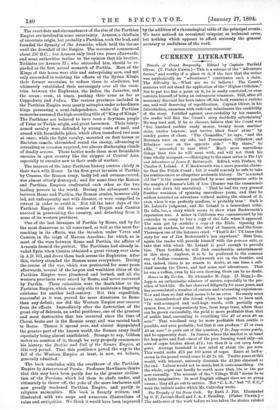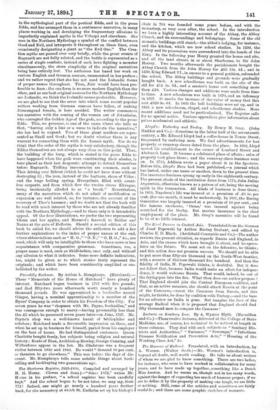in the mythological part of the poetical Edda, and in
the prose Edda, and has arranged them in a continuous narrative, in many places working in and developing the fragmentary allusions to imperfectly explained myths in the VOluspa and elsewhere. She sees in the Northern Mythology a symbol of the conflict between Good and Evil, and interprets it throughout on these lines, even occasionally designating a giant as "the Evil One." The Crea- tion myths are passed over very briefly, while the great events of RagnarOk are not fully related, and the battle is represented as a series of single combats, instead of each hero fighting a monster simultaneously, the stern simplicity of the original narratives being here entirely lost. The authoress has based her work on various English and German sources, enumerated in her preface ; and we rather regret that she has not used the Icelandic forms of proper names throughout. Thus, Asir would have been pre- ferable to Asen. ; the one form is no more modern English than the other, and as our best original sources for the Northern Mythology are Icelandic, we think the Icelandic names preferable. However, we are glad to see that the error into which some recent popular writers working from German sources have fallen, of making Jormungand female, is here avoided. The writer commences her. narrative with the coming of the women out of Jotunheim, who corrupted the Golden Age of the gods, according to the prose Edda. This, we presume, is one of the cases where she tells us that, "having only a line or a verse to indicate the narrative," she has had to expand. Two of these giant maidens are repre- sented as Skadi and Gerd ; but we doubt whether there is any warrant for connecting them with the former myth. Nor do we think that the order of the myths is very satisfactory, though the Eddas themselves are not always very clear on this point. Thus, the building of the burg, which is stated in the prose Edda to have happened when the gods were constructing their abodes, is here placed as their last desperate attempt to defend themselves before Ragnarok. Trifling inaccuracies are common, such as Thor driving over Bifrost (which he could not have done without destroying it) ; the iron, instead of the leathern, shoes of Vidar ; and the huge boiling spring, Hvergelmir, filled with count- less serpents, and from which flow the twelve rivers Elivagar, being incidentally alluded to as " a brook." Nevertheless, many of the narratives which do not admit of modification or expansion are well related, as, for instance, the account of the recovery of Thor's hammer ; and we doubt not that the book will be read with much interest by those who are not already familiar with the Northern Mythology,—and to those only is it intended to appeal. Of the four illustrations, we prefer the two representing Munn and her apples, and Hermod's farewell to Baldur Nanna at the gate of Helheim. Should a second edition of this book be called for, we should advise the authoress to add a few further explanations to the index of proper names at the end, where abbreviations such as " M. G.," " O. N.," " 0. H. G.," tic., are used, which will only be intelligible to those who have more or less acquaintance with comparative grammar. Sometimes, too, a proper name is used, such as Skidbladnir, once only, and without any allusion to what it indicates. Some more definite indications, too, might be given as to which stories fairly represent the -originals ; and which have been considerably amplified or em- bellished by the writer.



















































 Previous page
Previous page